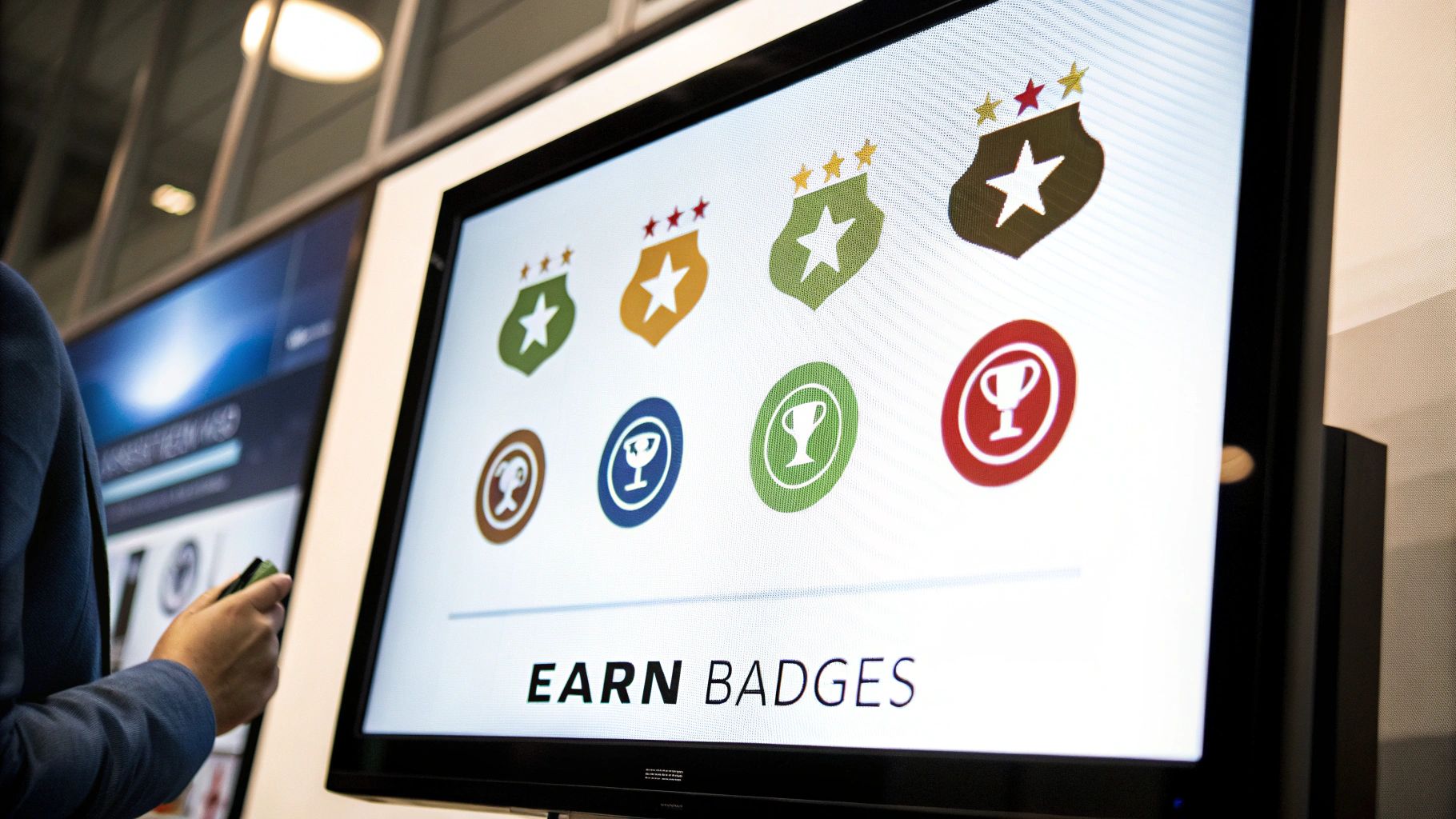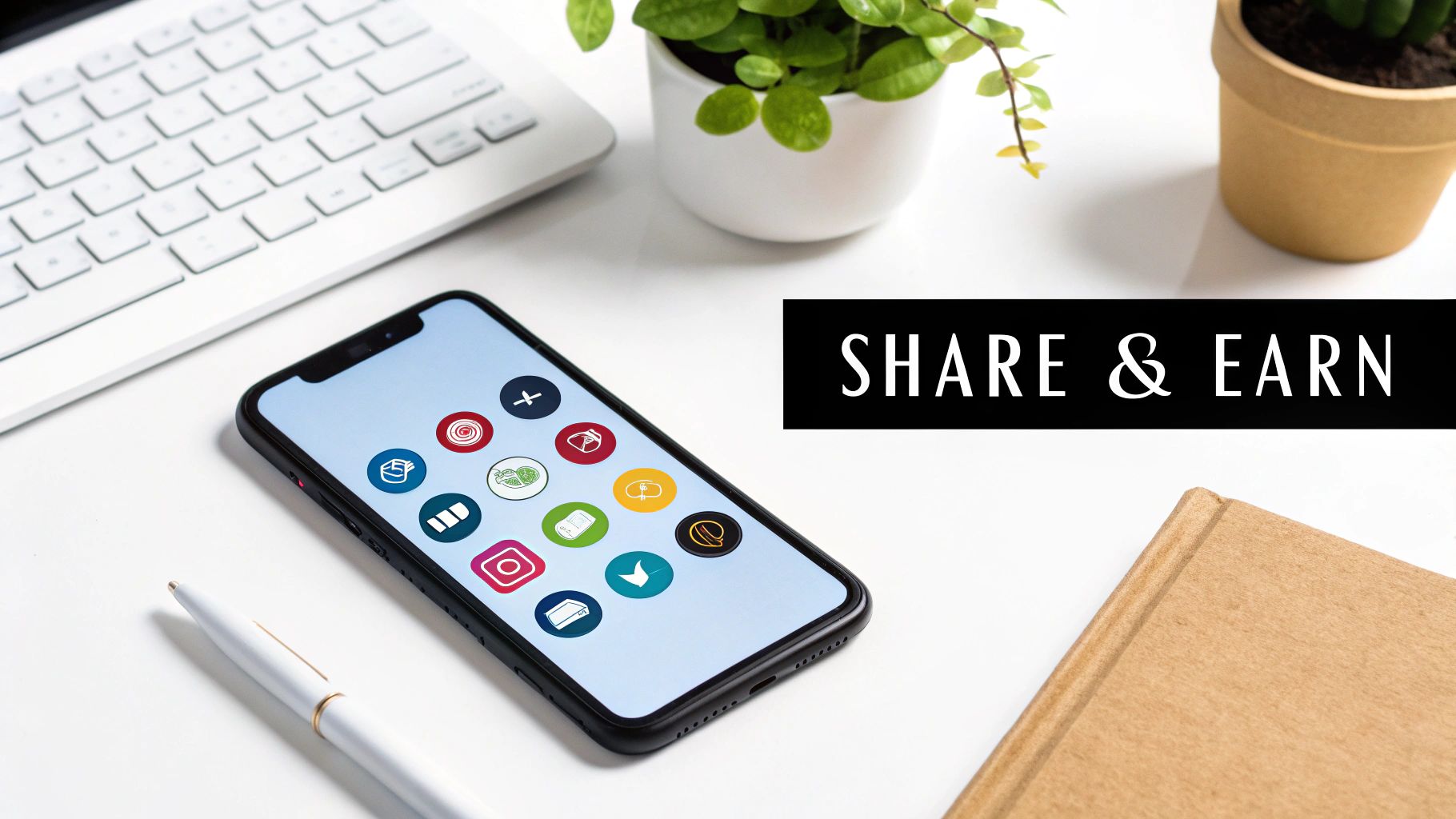While traditional 'refer-a-friend' programs have their place, the SaaS landscape demands more sophisticated strategies to cut through the noise. Standard incentives are no longer enough to capture attention and drive meaningful, scalable growth. For modern SaaS businesses, the key lies in leveraging creative, embedded referral marketing ideas that integrate seamlessly into the user experience.
This article moves beyond generic advice to provide a deep dive into 10 powerful, actionable referral strategies tailored for SaaS. We'll explore how to transform your existing user base into a powerful acquisition engine using tactics from gamification and VIP exclusivity to AI-powered personalization. The focus is on implementing these programs natively within your application, creating a frictionless experience that feels like a natural part of your product. To delve deeper into the fundamental concepts of building a successful system, exploring a dedicated referral program can provide valuable insights.
By the end of this list, you'll have a playbook of fresh, innovative referral marketing ideas designed to:
- Acquire high-quality users through trusted recommendations.
- Boost customer loyalty and reduce churn.
- Build a self-sustaining growth loop directly within your product.
Get ready to discover strategies that will not only attract new customers but also deepen engagement with your current ones.
1. Double-Sided Incentive Programs
A double-sided incentive program is a powerful referral marketing idea that rewards both the person making the referral (the advocate) and the new customer they bring in. This creates a compelling win-win scenario, where the existing user is motivated to share because they get a reward, and the new user is incentivized to sign up because they also receive a benefit. It’s a strategy built on mutual value.
This approach effectively turns your customer base into a proactive sales force. Instead of a one-way transaction, the referral feels more like a shared gift, which significantly boosts conversion rates. For SaaS businesses, this method is especially potent for driving both user acquisition and long-term retention.

Why It Works So Well
The core strength of this model lies in its psychological appeal. It removes any feeling of selfishness from the referral process. Advocates feel good about sharing a valuable offer with their network, not just earning a reward for themselves. This sense of fairness and generosity is a key driver of participation and one of the most effective referral marketing ideas you can implement.
A famous example is Dropbox, which offered extra storage space to both the referrer and the new user. This simple, high-value exchange was a cornerstone of its early product-led growth.
How to Implement It
- Balance the Rewards: Ensure the value given to both parties is attractive but doesn't compromise your profitability. The combined cost of the rewards should be less than your average Customer Acquisition Cost (CAC).
- Offer Relevant Incentives: For SaaS, cash is not always king. Consider rewards like subscription credits, access to premium features, or extended trial periods. These non-cash incentives often have a higher perceived value and lower actual cost.
- Set Clear Conditions: Clearly define what constitutes a successful referral. Does the new user need to sign up, activate their account, or become a paying subscriber? Ambiguity here can lead to frustration and hurt your program. You can discover more about building a strong foundation for your program by exploring these SaaS marketing ideas for referrals on Refgrow.com.
2. Gamified Referral Systems
Gamified referral systems transform the standard referral process into an engaging and competitive experience by incorporating game-like elements. This approach uses points, achievement badges, leaderboards, and progress bars to tap into intrinsic human motivators like competition, status, and the desire for accomplishment. It makes sharing more of a fun challenge than a transactional task.
By turning referrals into a game, you encourage repeat participation and create a more memorable brand interaction. This is one of the most effective referral marketing ideas for fostering a loyal community around your product, as users become invested in their progress and status within the program.

Why It Works So Well
The success of gamification lies in its ability to provide instant feedback and a sense of achievement. When users see a progress bar fill up or a new badge appear on their profile, they receive a small dopamine hit that encourages them to continue the desired behavior. Leaderboards add a social and competitive layer, motivating top performers to maintain their rank and inspiring others to climb higher.
A well-known example is the Starbucks Rewards program, where customers earn "Stars" for purchases and referrals. These stars unlock different tiers of rewards, creating a clear path of progression that keeps customers engaged and motivated to spend and share more.
How to Implement It
- Keep It Simple: The rules of the game should be easy to understand. Users need to know exactly what actions earn points and what those points can be redeemed for.
- Provide Visible Progress: Implement visual cues like progress bars or point counters so advocates can easily track how close they are to the next reward. This constant feedback is crucial for motivation.
- Offer Meaningful Rewards: The rewards should align with your brand and be genuinely desirable. Beyond discounts, consider exclusive access, special titles, or unique digital badges that confer status within your community.
- Implement Anti-Fraud Measures: Competitive systems can sometimes attract cheaters. Ensure you have clear rules and monitoring in place to prevent users from gaming the system with fake referrals, which protects the integrity of your program.
3. Social Media Advocacy Programs
A social media advocacy program transforms your most engaged users into brand ambassadors on their favorite platforms. This referral marketing idea encourages participants to share branded content, personal experiences, or unique referral links across their social networks. In return, they receive rewards, turning organic social proof into a scalable acquisition channel.
This strategy capitalizes on the trust inherent in social connections. When a friend posts about a product, it carries more weight than a traditional advertisement. For SaaS businesses, this method is excellent for building community and reaching niche audiences through authentic, user-generated content that drives conversions.

Why It Works So Well
The power of social media advocacy lies in its authenticity and reach. It allows your brand message to be shared in a user's genuine voice, which resonates deeply with their network. This creates a ripple effect where a single share can influence dozens or even hundreds of potential customers.
A notable example is Glossier, which built its empire by empowering its community to share their experiences on Instagram. Their referral program became an engine for viral growth, turning everyday users into influential micro-advocates.
How to Implement It
- Provide Shareable Assets: Equip your advocates with high-quality, pre-made content like branded images, video clips, and post templates. Make it easy for them to share with one-click buttons for major platforms like Twitter, LinkedIn, and Facebook.
- Encourage Authentic Storytelling: While templates are useful, encourage users to share their personal success stories. Prompt them with questions about how your SaaS has solved a specific problem for them. Authenticity is far more compelling than a generic promotional post.
- Create Platform-Specific Strategies: Tailor your campaigns to the strengths of each social network. For instance, use visually appealing content for Instagram, professional case studies for LinkedIn, and quick, engaging updates for Twitter.
4. VIP/Exclusive Access Programs
A VIP or exclusive access program leverages the power of status and exclusivity as a primary referral incentive. Instead of offering cash or discounts, this strategy rewards successful referrers with special privileges, early access to new features, or entry into an elite community. It transforms your most loyal users into brand ambassadors by making them feel like valued insiders.
This approach is particularly effective for SaaS companies with a strong brand identity and an engaged user base. The desire to gain a special status can be a more powerful motivator than a simple monetary reward. These referral marketing ideas tap into a customer's aspiration for recognition and unique experiences, fostering a deeper, more emotional connection to your product.
Why It Works So Well
The appeal of this model is rooted in the psychological principle of social proof and exclusivity. People are naturally drawn to things that are scarce or hard to obtain. By creating a VIP tier, you generate desire and curiosity, encouraging others to refer friends so they too can join the exclusive group. It's a self-perpetuating cycle of aspiration and advocacy.
A great example is Lululemon's Ambassador Program, which provides top community members with exclusive gear and opportunities, turning them into powerful advocates. Similarly, credit card companies like American Express have long used exclusive event access as a major perk.
How to Implement It
- Define Valuable, Non-Monetary Perks: Your exclusive benefits must feel genuinely special. This could include early access to beta features, a direct line to your product team, invitations to exclusive webinars, or special recognition within the community.
- Create Clear Tiers: Structure your program with escalating levels of exclusivity. A user might start by earning a special badge and progress to unlocking one-on-one sessions with your support team after multiple successful referrals.
- Showcase the Experience: Don't keep your VIP benefits a secret. Publicly celebrate your top referrers and highlight the exclusive experiences they've earned. This creates FOMO (Fear Of Missing Out) and motivates others to participate.
- Deliver on the Promise: The VIP treatment must live up to its name. If the exclusive access feels underwhelming, it will backfire and damage trust. Ensure the experience is premium and consistently delivered.
5. Charity/Cause-Based Referral Programs
A cause-based referral program is an altruistic approach that ties rewards to social good. Instead of offering a direct financial incentive to the advocate or new customer, a donation is made to a charity or social cause when a successful referral is completed. This strategy taps into the desire to make a positive impact and builds a strong, value-aligned connection with your audience.
This method transforms a transactional referral into a meaningful act of giving back, strengthening your brand's reputation as a socially responsible company. It's one of the most powerful referral marketing ideas for attracting and retaining customers who prioritize purpose over profit.

Why It Works So Well
The effectiveness of this model stems from its appeal to intrinsic motivation. Participants are driven by a sense of shared purpose and the satisfaction of contributing to a cause they care about. This can foster a deeper level of brand loyalty than monetary rewards alone. It aligns your brand with powerful emotional drivers, creating advocates who are passionate about both your product and your mission.
Companies like TOMS and Bombas have built their brands around this concept. For every referral that leads to a purchase, they donate a product to someone in need, making their customers feel like partners in their social mission.
How to Implement It
- Align with Brand Values: Select charitable causes that genuinely resonate with your company's mission and your customers' interests. Authenticity is crucial for this strategy to succeed.
- Offer Choice and Transparency: If possible, allow users to choose from a pre-vetted list of charities. Provide a clear dashboard or regular updates showing the collective impact the referral program is having.
- Communicate the Impact: Clearly articulate how each referral translates into a tangible outcome, for example, "Your referral just provided 10 meals." This makes the contribution feel real and significant.
6. Milestone-Based Referral Rewards
Milestone-based referral rewards create a gamified experience by offering increasingly valuable incentives as advocates reach specific referral targets. Instead of a single, static reward, this system introduces a progressive journey, motivating participants to keep sharing over the long term. It’s an excellent way to turn casual referrers into dedicated, high-performing brand ambassadors.
This approach taps into the human desire for achievement and progress. By structuring rewards in tiers, you encourage sustained effort and prevent the program from feeling stale. This is one of the most effective referral marketing ideas for fostering a community of super-users who continuously drive growth for your SaaS platform.
Why It Works So Well
The power of this strategy lies in its ability to build momentum. The initial milestones are easy to reach, providing a quick win that hooks participants. As they progress, the rewards become more enticing, creating a powerful incentive to aim for the next level. This gamification keeps your top referrers engaged and consistently contributing to your acquisition funnel.
A prime example is Morning Brew, the popular business newsletter. They offer rewards ranging from exclusive content for one referral to a laptop for 1,000 referrals. This tiered system successfully built a loyal army of readers who powered their exponential growth.
How to Implement It
- Set Achievable Milestones: Design your tiers with a low barrier to entry. The first milestone might require just one or two successful referrals to give advocates an early sense of accomplishment and keep them motivated.
- Visualize Progress: Provide a clear dashboard or progress bar where users can see how many referrals they've made and what the next reward is. Visual feedback is crucial for maintaining engagement and encouraging the next share.
- Offer Compelling Rewards: Make sure the rewards scale in value and desirability. Combine digital perks like feature unlocks or subscription credits with exclusive physical merchandise for your top-tier advocates to create a truly aspirational program.
7. Partnership and Cross-Brand Referrals
Partnership and cross-brand referrals involve collaborating with complementary, non-competing brands to create a shared referral program. Instead of just rewarding users for referring customers to your own service, you expand the ecosystem, allowing customers from both businesses to refer and earn rewards across a wider network. This turns a standard referral program into a strategic business alliance that mutually benefits all parties involved.
This powerful approach taps into new, relevant audiences you couldn't otherwise reach. By partnering with a brand whose customers align with your ideal user profile, you gain a warm introduction to a pre-qualified pool of potential users. This is one of the most effective referral marketing ideas for scaling acquisition beyond your existing customer base and creating powerful market synergy.
Why It Works So Well
The strength of this strategy lies in its ability to offer enhanced value and choice. Customers appreciate being rewarded with benefits from other brands they already use and trust, which increases the perceived value of the reward itself. For the businesses, it’s a cost-effective way to acquire high-quality leads and build brand authority through association.
A classic example is the Chase Ultimate Rewards program, where cardholders can transfer points to numerous airline and hotel partners like United and Hyatt. This creates a highly valuable and flexible rewards ecosystem that drives loyalty for all participating brands.
How to Implement It
- Choose Complementary Partners: Identify brands that serve a similar customer demographic but aren't direct competitors. For example, a project management SaaS could partner with a time-tracking tool.
- Establish Clear Agreements: Create a formal partnership agreement that outlines commission structures, data-sharing protocols, and tracking responsibilities. Define exactly what a qualified referral looks like for both sides to avoid any confusion.
- Create a Seamless User Experience: The referral process should feel integrated and smooth. Use API integrations or shared landing pages to ensure customers can easily claim rewards without navigating a confusing or disjointed journey.
- Promote the Partnership Actively: Both partners must commit to promoting the program to their respective audiences through email newsletters, in-app notifications, and social media to maximize visibility and participation.
8. Influencer and Affiliate Referral Hybrid
An influencer and affiliate referral hybrid program merges the trust of traditional peer-to-peer referrals with the reach and commission structure of affiliate marketing. This strategy empowers your most loyal customers to become high-earning advocates, effectively blurring the line between a happy user and a professional affiliate. It allows regular users to earn influencer-style commissions while preserving the authenticity of a personal recommendation.
This approach gives your super-users a path to graduate from a simple referral program to a more structured, rewarding partnership. By providing them with better tools and higher incentives, you can unlock a powerful and scalable acquisition channel. This is one of the more advanced referral marketing ideas, perfect for businesses with a highly engaged user base.
Why It Works So Well
The power of this model comes from its scalability and authenticity. It leverages the genuine enthusiasm of your best customers and gives them a financial incentive to promote your product more widely. Unlike traditional influencers who may not be actual users, these advocates offer social proof backed by real-world experience, making their recommendations incredibly persuasive.
A prime example is Shopify's affiliate program, which allows anyone from a small business owner to a major industry influencer to earn recurring commissions. This tiered structure encourages long-term partnerships and drives high-quality leads.
How to Implement It
- Provide Professional Resources: Equip your advocates with a dedicated dashboard, unique tracking links, and a library of marketing materials like banners, email templates, and talking points.
- Offer Performance-Based Tiers: Create tiered commission structures that reward top performers. For instance, an advocate could start at a 15% commission and move up to 25% after referring 10 paying customers. This gamifies the experience and motivates them to perform better.
- Focus on Quality Control: Implement clear terms of service and fraud detection to protect your brand's integrity. Ensure advocates represent your product accurately and ethically. For hybrid models involving influencers, understanding the ROI of influencer marketing is crucial to gauge effectiveness.
- Maintain Clear Communication: Keep your super-users engaged with regular updates, performance insights, and training. You can explore effective strategies and best practices by learning more about affiliate program management on Refgrow.com.
9. Experiential and Event-Based Referrals
Experiential referrals move beyond traditional cash or product rewards, offering advocates unique experiences and event access instead. This approach ties your brand to memorable, high-value moments, fostering a deep emotional connection with your most loyal users. Instead of a transaction, a referral becomes a ticket to an exclusive activity.
This strategy is exceptionally effective for brands with strong community or lifestyle elements. The goal is to create "money-can't-buy" opportunities that not only reward advocates but also generate organic social proof and buzz. For SaaS companies, this could mean VIP access to industry conferences, exclusive workshops with thought leaders, or invitations to special networking events.
Why It Works So Well
The power of this referral marketing idea lies in its ability to create lasting memories. An experience is far more shareable and emotionally resonant than a simple discount. When a user attends an exclusive event thanks to your brand, they don't just feel rewarded; they feel like an insider. This strengthens loyalty and transforms them into passionate, long-term evangelists.
A prime example is Mastercard's Priceless Experiences program, which gives cardholders exclusive access to unique events, from celebrity meet-and-greets to private tours. This reinforces the brand's identity and value proposition far beyond its core financial services.
How to Implement It
- Align Experiences with Brand Identity: Ensure the events or activities reflect your company’s values and appeal to your target audience. A B2B SaaS might offer a high-level mastermind session, while a creative tool could offer a design workshop.
- Create Shareable Moments: Design events with social media in mind. Incorporate photo opportunities, unique activities, and branded swag that encourage attendees to post about their experience, generating powerful user-generated content.
- Offer a Range of Options: To appeal to diverse interests, consider offering a menu of experiences. When designing these, the key is audience participation. You can find inspiration by exploring various engaging workshop activities to make your events more memorable.
- Ensure Flawless Execution: The quality of the experience is paramount. A poorly organized event can do more harm than good, so invest in professional execution to deliver on the promise of exclusivity and value.
10. AI-Powered Personalized Referral Programs
An AI-powered personalized referral program leverages machine learning to tailor every aspect of the referral experience to the individual user. Instead of offering a one-size-fits-all incentive, this advanced approach analyzes customer behavior, engagement history, and demographic data to determine the optimal reward, timing, and messaging for each person. This hyper-personalization makes the referral offer feel uniquely relevant and significantly increases the likelihood of participation.
This strategy moves beyond basic segmentation and into predictive analytics. The system can identify which customers are most likely to become successful advocates and proactively prompt them at the perfect moment. For SaaS companies, this means turning data into a powerful engine for user acquisition, creating one of the most sophisticated referral marketing ideas available.
Why It Works So Well
The effectiveness of this model comes from its deep relevance. When a referral offer aligns perfectly with a user's motivations, whether it’s a specific feature upgrade they’ve shown interest in or a cash reward, the incentive becomes almost irresistible. It feels less like a generic marketing campaign and more like a tailored opportunity.
Amazon uses its powerful recommendation engine to suggest products that a user's friends might like, making the act of sharing more targeted and effective. Similarly, LinkedIn targets referral prompts based on a user's professional network and connections, increasing the odds of a successful match.
How to Implement It
- Start with Simple Personalization: You don't need a massive data science team from day one. Begin by personalizing offers based on user segments, such as power users versus new customers, before layering in more complex AI algorithms.
- Maintain Transparency: Be clear with your users about how their data is used to create personalized offers. Transparency builds trust, which is essential for any referral program's success.
- Continuously Test and Optimize: AI models improve with data and iteration. A/B test different rewards, messages, and timing triggers to continuously refine your program’s performance.
- Provide an Opt-Out: Always give customers the choice to opt-out of personalized offers and receive a standard referral incentive instead. This respects user preference and privacy. To get this right, you can explore the fundamentals of building a trusted program by reading about referral program best practices on Refgrow.com.
Referral Marketing Ideas Comparison Matrix
| Referral Program Type | Implementation Complexity 🔄 | Resource Requirements ⚡ | Expected Outcomes 📊 | Ideal Use Cases 💡 | Key Advantages ⭐ |
|---|---|---|---|---|---|
| Double-Sided Incentive Programs | Medium - requires automated tracking systems | Moderate - costs higher due to double rewards | Increased participation and retention | Businesses seeking mutual customer rewards | Win-win motivation; strong customer acquisition |
| Gamified Referral Systems | High - complex setup and ongoing maintenance | High - continuous content and challenge updates | High engagement and long-term participation | Brands targeting competitive, achievement-driven users | Engaging and viral; encourages ongoing activity |
| Social Media Advocacy Programs | Medium - content creation and monitoring needed | Moderate - marketing and social media tools | Broadened reach and authentic peer recommendations | Brands leveraging social platforms for amplification | Massive reach potential; cost-effective brand growth |
| VIP/Exclusive Access Programs | Medium to High - operational coordination needed | Moderate - event and experience management | Strong emotional brand connection and loyalty | Premium brands offering status and exclusivity | Creates exclusivity; lower direct reward costs |
| Charity/Cause-Based Referral Programs | Medium - requires charity vetting and reporting | Low to Moderate - donation administration | Positive brand image and emotional consumer ties | Socially conscious brands focusing on impact | Appeals to values-driven consumers; PR benefits |
| Milestone-Based Referral Rewards | High - sophisticated tracking and tier setup | Moderate to High - escalating rewards | Long-term engagement and identification of advocates | Brands emphasizing sustained referral activity | Motivates ongoing referrals; proportional rewards |
| Partnership and Cross-Brand Referrals | High - complex partnership & data management | High - coordination between brands | Expanded customer base and shared marketing costs | Complementary brands seeking cross-promotion | Broader rewards; shared costs and customer access |
| Influencer and Affiliate Hybrid | High - advanced tracking and commission systems | High - payment processing and fraud prevention | Scalable, high-impact peer and influencer marketing | Brands combining influencer reach with customer referrals | Higher earning motivation; authentic peer marketing |
| Experiential and Event-Based Referrals | High - event planning and quality control | High - operational costs for experiences | Memorable brand interactions and emotional bonding | Brands focusing on unique, experience-driven rewards | Creates emotional connections; differentiates brand |
| AI-Powered Personalized Referral Programs | Very High - AI development and data requirements | High - data infrastructure and privacy measures | Optimized conversion and personalized customer experience | Data-driven brands seeking precision marketing | Personalized rewards; data-driven optimization |
Putting Your Referral Engine into Motion
We've explored a powerful spectrum of referral marketing ideas, moving far beyond the simple "give a discount, get a discount" model. From the mutual benefit of double-sided incentives and the engaging fun of gamified systems to the community-building power of VIP programs and cause-based initiatives, it's clear that a modern referral strategy is not a one-size-fits-all solution. Instead, it’s a dynamic, integrated growth engine that should feel like a core part of your product experience.
The most successful SaaS companies treat their referral program as a product in itself. This means it requires thoughtful design, continuous A/B testing, and deep integration into the user journey. The goal is to make the act of referring feel like a natural, valuable, and rewarding extension of using your software, not a disruptive marketing ask.
Key Takeaways for Building Your Program
To transform your satisfied users into a powerful, self-sustaining acquisition channel, focus on these core principles drawn from the ideas we've covered:
- Align Incentives with Value: The reward must resonate with both the referrer and the new customer. Whether it's a financial discount, exclusive feature access (VIP Programs), or a shared charitable donation, the incentive should feel meaningful and directly connected to your brand's value.
- Reduce Friction at Every Step: The process of finding a referral link, sharing it, and tracking progress must be seamless. This is where embedded affiliate software becomes critical, eliminating clunky external dashboards and integrating the program directly into the user’s natural workflow.
- Embrace Personalization and Segmentation: As highlighted by AI-powered programs and tiered milestone rewards, not all users are motivated by the same thing. Segment your audience and tailor your referral offers. A power user might be driven by a significant commission, while a new, happy customer might just need a small nudge.
- Think Beyond the Transaction: Strategies like partnership referrals, influencer hybrids, and social advocacy programs show that the most impactful referral marketing ideas build relationships. They create a network effect that strengthens your brand's community and market presence far beyond a single conversion.
Your Actionable Next Steps
Building a sophisticated referral engine from scratch can be a major engineering undertaking. However, you don't need to delay your growth. Your immediate focus should be on selecting one or two of the strategies that best align with your user base and business model.
Start by asking critical questions: Are your users highly engaged and competitive? A gamified system might be perfect. Is your brand built around a strong community or mission? A cause-based or VIP program could be a natural fit. Once you have a direction, the next step is implementation. Choose a tool that allows for rapid deployment and iteration, enabling you to test, learn, and scale what works without siphoning development resources away from your core product.
The path to sustainable, user-driven growth is clear: choose the right idea, implement it seamlessly, and give your customers the power to become your most effective and authentic marketing channel.
Ready to turn these referral marketing ideas into a powerful, automated growth engine? Refgrow provides the embeddable, one-line-of-code infrastructure to launch, track, and scale a world-class program directly within your SaaS application. Skip the heavy engineering lift and start building your referral machine today.

